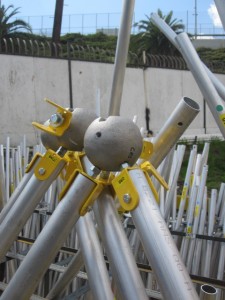
Featured at Coachella Music and Arts Festival in 2014, Lightweaver was designed by Alexis Rochas and Andreas Froech. This joint project by Stereo.bot and Obscura is the beautiful fusion of architectural study, interactive multimedia and dynamic lighting. Towering above the Polo Fields at 45 feet tall with a diameter of 75 feet, the main sculpture provided shade with a shifting shadow silhouette during the day and lit up after sunset, providing an awesome projection mapping experience with warm ambient colors and light tracing contour effects. This “breathing” sculpture provided an intricate canvas for festival go-ers at night. [1]
This project came to fruition as a result of the ambitious, futuristic vision of the creators. Referred to as a “cube of complexity”, the Mobius strip/double helix looking structure embodies complex construction. Because Coachella is primarily a music festival, the artists wanted to concoct a magical space of gathering for all festival attendees; they wanted create the same intense, spectacular experience the musicians brought, but architecturally. With this, they designed double compound curves that translate 150 feet across the piece and then come back and land where they need to land with ⅛ of an inch precision. With this, they were able to utilize a new technique called light mapping, or moving head lights that trace the contours of the structure. [3]
Construction was not an easy task as both designers explored new unchartered territories. Andreas was in charge of the “skin”, or canvas, diving into new areas with computer development, planning everything using 3D models before bringing the pieces on site, making construction look easy. Meanwhile, Alexis worked on the structure. The project comprises of over 2,000 metal tubes and hundreds of heavy metal balls, each with a unique arrangement of holes drilled by a robot programmed by Andreas. The complex frame is then covered in a specially designed fabric.

Node (metal ball) of Lightweaver, with many tubes attached
Lightweaver is also a space frame system, meaning it is a combination of linear elements that achieve more strength as you start triangulating the network together. Instead of achieving strength with additional material, you achieve strength and support using laws of geometry so that every piece is related to one another, making the piece inherently structural. In the past, this had been constrained by fabrication methods but Alexis and Andreas broke these barriers by streamlining the technical aspects so that the universal nodes in Lightweaver simplify the process.
An important thing to takeaway from this project is the combination of robotic programming, electrical engineering, design, and architecture to develop new techniques and create beautiful art pieces. With these, Lightweaver is a structural system that embodies the different aspects of physical computing. One of the challenges Andreas faced was realizing the physical forms that he designed during construction. On site, he faced lots of error when he couldn’t maintain the computer structure of the planned pieces. However, once he managed to maintain his templates, he was able to make a very grandiose piece that was mobile at the same time – this piece was easily (relatively) deconstructed and reconstructed, an important aspect that can applied to our own projects for the museum while also featuring the importance of prior design. [4]
Leave a Reply
You must be logged in to post a comment.